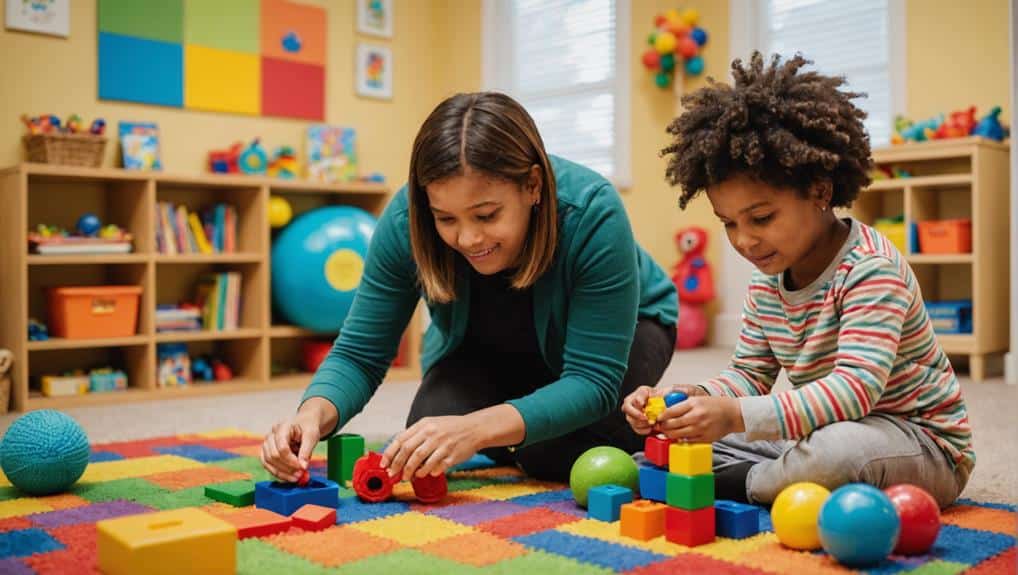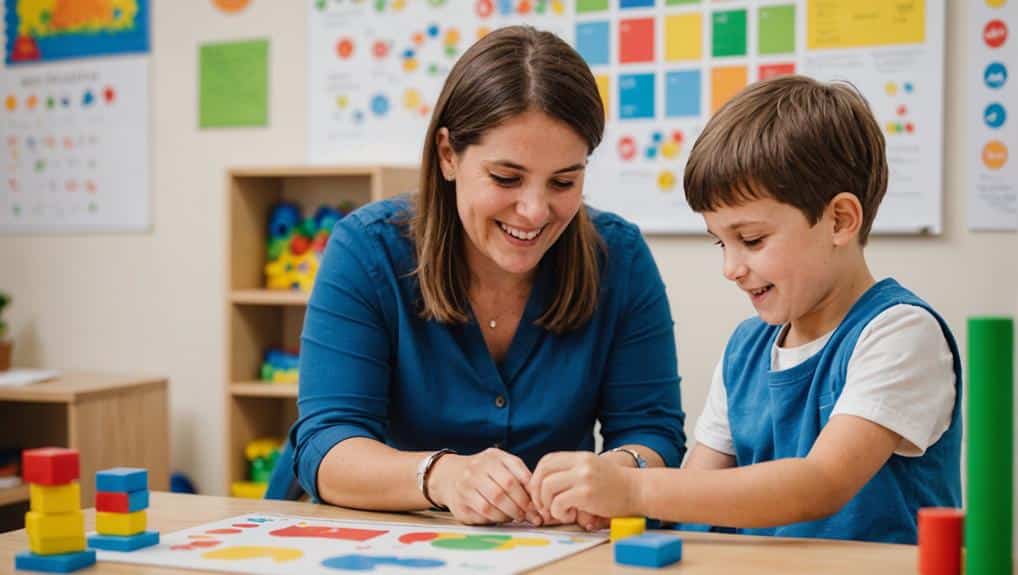Expert Autism Therapy, specifically the Developmental Personal-difference Relationship-based model or DIR/Floortime, presents a distinct, all-encompassing approach to nurturing the developmental progress of children with autism. This strategy accentuates the cultivation of communication skills, social interaction, and heartfelt regulation through tailored interventions, fostering growth and meaningful relationships. The compelling question remains: how does this approach compare with other therapies, and how can parents cost-effectively access these services?
Key Takeaways
- DIR/Floortime therapy enhances a child’s communication, social interaction, and emotional regulation skills, supporting their overall development.
- The therapy uses customized interaction strategies tailored to each child’s unique developmental pathway, fostering emotional growth and meaningful connections.
- Floortime therapy leverages a child’s interests and passions for communication, growth, and connection, integrating sensory, emotional, and motor experiences.
- Parental involvement in DIR/Floortime therapy strengthens the parent-child bond, enhances communication and emotional development, and shapes the therapy experience.
- Financial assistance programs, insurance coverage, sliding-scale fees, and community resources can help secure affordable access to Floortime therapy.
Understanding DIR/Floortime Therapy
Diving into the realm of autism therapies, one approach stands out for its emphasis on significant, respectful interaction: the Developmental Unique-difference Relationship-based model or DIR/Floortime therapy. This method, often integrated into pediatric occupational therapy, is renowned for its focus on nurturing development through engaging interactions rooted in the DIR model. It highlights the crucial role of relationships interpersonal connections play in improving self-regulation, communication, and problem-solving skills.
Just like in pediatric OT, the charm of DIR/Floortime therapy lies in its wide-ranging application, as it can be utilized anytime, anywhere. This accessibility enables it to reach children on the autism spectrum in diverse settings, opening avenues for consistent, continuous learning. The therapy method follows the child’s lead, pushing them to grow based on their emotional interests, making the learning experience more intimate and impactful.
Utilized widely by professionals and caregivers worldwide, this evidence-based approach is a testament to the power of meaningful engagement for individuals on the autism spectrum. DIR/Floortime therapy is not just a method; it’s a rich tapestry of interactions designed to nurture growth, development, and understanding. It is a tool for unleashing potential, one interaction at a time.
Core Principles of DIR/Floortime
Building on the understanding of DIR/Floortime therapy‘s fundamental approach, examining the core principles that shape this exclusive and efficient therapy becomes crucial. Central to DIR/Floortime is the prioritization of customized interaction strategies uniquely tailored to each child’s specific developmental pathway. This approach, rooted in empathy and understanding, fosters emotional growth, providing the foundation for meaningful connections and promoting social engagement. It’s similar to how pediatric OTs use evidence-based strategies to improve children’s social interactions and emotional management skills.
Further, by highlighting emotional development, DIR/Floortime boosts communication skills, a critical marker in child development. This focus also promotes self-regulation, enabling children to appropriately manage their behaviors and reactions, a crucial skill for overall growth.
Perhaps one of the most distinct aspects of DIR/Floortime is applying a non-directive approach. This principle encourages children to lead interactions, fostering their autonomy and confidence. By allowing children to take the initiative, the therapy taps into their interests, utilizing their passion for optimal engagement and significant developmental gains. Therefore, the core principles of DIR/Floortime therapy demonstrate its potential to guide children on the autism spectrum toward fulfilling and productive lives.
Individualized Interaction Approaches

Personalized interaction approaches in autism therapy focus on each child’s distinctiveness, leveraging their interests to foster communication and sentimental growth. Techniques like DIRFloortime employ customized engagement strategies, integrating sensory, sentimental, and motor experiences into therapy sessions. With the child’s limited range of interests in mind, the therapy sessions are tailored to tap into these interests, creating a more engaging and effective therapeutic environment. Therapists can adapt interventions to the child’s developmental trajectory by nurturing circles of communication and enhancing their relational skills and sentimental well-being.
Personalized Engagement Techniques
In the vast landscape of autism therapy, customized engagement techniques, specifically DIRFloortime’s individualized interaction approaches, are a powerful tool for parents. These methodologies hinge on the child’s developmental trajectory, capitalizing on their distinct interests to foster an environment of understanding and responsiveness. Much like the ADHD therapies used in Tampa, FL, these approaches are designed to improve focus, motor skills, and executive functioning, all while nurturing heartfelt growth and engagement.
The core of these tailored techniques is a nurturing ethic that fosters heartfelt growth and engagement by utilizing a child’s inherent curiosities. This engagement becomes a conduit for improving communication skills, fostering a bond between child and parent that transcends the challenges posed by autism.
The DIRFloortime method, in its non-directive stance, encourages the child to take the lead in the interaction. This approach, coupled with a sensory, heartfelt, and motor experience tailored to the child’s preference, results in significant developmental gains. It strengthens emotional reciprocity and cultivates a heightened sense of connection.
Nurturing Emotional Growth
Centering on the child’s specific interests and needs, individualized interaction approaches in DIRFloortime therapy offer a powerful avenue for nurturing emotional growth. This tailored engagement utilizes the child’s passions and interests to strengthen connection, fostering crucial communication milestones. The integration of sensory experiences and motor development promotes meaningful interactions and growth.
| Approaches | Benefits |
|---|---|
| Tailored Engagement | Strengthens connection, nurtures emotional growth |
| Sensory and Motor Experiences | Promotes meaningful interactions, aids in development |
| Non-Directive Approach | Fosters independence boosts emotional reciprocity |
The non-directive approach encourages the child to take the lead, resulting in significant developmental gains. This nurturing communication is essential for fostering symbolic thinking, a critical aspect of emotional growth. Moreover, the focus on emotional reciprocity helps children engage more effectively with their environment.
Harnessing Child’s Interests
Utilizing a child’s interests forms the cornerstone of DIRFloortime therapy’s personalized interaction approaches. This original model is designed to use children’s passions and preferences, fostering pivotal milestones in communication and emotional growth. This model targets communication development and aids in emotional regulation, a fundamental aspect of child development and independence.
DIRFloortime therapy creates a rich tapestry of sensory, emotional, and motor experiences to enrich connection and engagement. These personalized approaches are tailored to the child’s unique developmental trajectory, ensuring an ideal balance between challenge and comfort. This balance is vital as it promotes resilience in children, enabling them to overcome developmental delays.
By adopting a non-directive stance, DIRFloortime allows the child to lead, promoting self-efficacy and autonomy. This approach facilitates nurturing circles of communication, advancing interaction, and promoting symbolic thinking. This therapy method aligns with fostering a nurturing setting for children to flourish, a critical aspect of pediatric occupational therapy.
Consequently, the child experiences significant developmental gains and progress. DIRFloortime therapy enables children to grow and thrive in distinct ways by nurturing their interests. It paves the way for a more meaningful, inclusive, and fulfilling life for children on the autism spectrum, demonstrating the impactful power of personalized, empathetic interaction.
Parental Involvement Importance
Understanding the significance of parental engagement in DIR/Floortime therapy is crucial for the child’s developmental progress. As primary agents of change in the DIR/Floortime approach, parents play an essential role in shaping their child’s growth. Their active participation in therapy sessions can lead to significant developmental advances, laying the foundation for improved communication skills, emotional development, and self-regulation.
Here are four key benefits of parental involvement in DIR/Floortime therapy:
- Strengthened Parent-Child Bond: Through active involvement, parents can enhance the emotional connection with their child, fostering mutual understanding and empathy.
- Advancement of Developmental Progress: Direct parental engagement can accelerate the child’s growth, thereby enhancing their adaptive behaviors and cognitive skills.
- Enhanced Communication Skills: Parents can help improve their children’s communication skills by modeling and reinforcing appropriate behaviors.
- Promoting Emotional Development and Self-Regulation: Parents can create a supportive environment that fosters emotional development and self-regulation, which are critical aspects of the DIR/Floortime approach.
With this awareness, parents can shape their child’s autism therapy experience, capitalizing on the unique opportunities presented by the DIR/Floortime approach.
Case Studies and Success Stories

Let us now focus on case studies and success stories highlighting the profound impact of DIR/Floortime therapy. These instances provide concrete examples of significant developmental strides in autistic children, emphasizing the tremendous value of tailored therapy approaches. They also underscore the pivotal role of parents as agents of change in these inspiring narratives of progress.
Real-Life Floortime Achievements
Through case studies and success stories, we witness the profound impact of DIR/Floortime therapy on children with autism. This integrative approach targets the child’s development and emphasizes parental involvement, transforming them into primary agents of change.
- Developmental Progress: The Floortime model has demonstrated significant developmental progress in autistic children. Focusing on meeting the child’s current developmental level and building upon their strengths has proved highly effective.
- Enhanced Communication: Success stories reveal how Floortime helps foster improved communication skills. The approach encourages children to express their feelings and thoughts, enriching emotional development.
- Emotional Connection: Floortime’s social-emotional focus has shown remarkable results in fostering emotional connection in autistic children. Through tailored therapy, children learn to connect better and engage with others.
- Key Achievements: With the DIR model, children demonstrate improved engagement, symbolic thinking, and self-regulation. These milestones indicate a promising trajectory for the child’s future.
The DIR/Floortime approach offers hope, providing autistic children the tools to navigate their world more confidently.
Inspiring Autism Progress Stories
Building on the foundation of genuine Floortime accomplishments, it becomes increasingly evident that this approach’s impactful effect is theoretical and profoundly practical. Inspiring autism progress stories from DIR/Floortime therapy showcase significant developmental strides in autistic children. Success stories highlight remarkable communication improvements, fostering emotional reciprocity and honing self-regulation abilities.
Parents, as primary agents of change in this therapeutic process, have witnessed improved social interactions and the development of adaptive skills in their children. Each child’s journey is distinct, and tailored therapy approaches have proven pivotal in fostering profound growth and development. These accomplishments are not restricted to therapy sessions alone; they permeate every aspect of the child’s life, setting the groundwork for a more fulfilling and independent future.
The power of DIR/Floortime therapy lies in its ability to tap into the child’s natural interests and motivations, making therapy a meaningful and enjoyable experience. The inspiring progress stories validate the effectiveness of this approach and offer hope to families navigating the intricacies of autism, reinforcing the belief that every child has the potential to make significant progress.
Emotional and Relational Development
While prioritizing feelings and relational development, the DIR/Floortime model of autism therapy focuses on nurturing sentiment growth and fostering a thorough understanding of a child’s emotions. This approach leads to a more profound functioning of sentiment, which is fundamental for a healthy and balanced life.
The DIR/Floortime model emphasizes:
- Personalized Interaction: Tailored to the child’s interests and developmental trajectory, facilitating engagement and meaningful connections.
- Nurturing Sentiment Growth: A safe and supportive environment optimizes a child’s emotional and relational development.
- Understanding the Child’s Emotions: This therapy aims to help the child grasp their emotions and how to cope with them, promoting emotional resilience.
- Enhancing Communication Skills: This model boosts communication skills by utilizing a child’s natural curiosities, enabling them to express their feelings better.
As a result, the DIR/Floortime model seeks to reach the child’s heart, fostering a sentiment intelligence that transcends beyond the therapy room and into their everyday lives. This empathetic and informed approach guarantees the child’s emotional and relational development is prioritized, leading to deep, meaningful connections and improved engagement.
Comparing Floortime With Other Therapies

In autism therapies, contrasting methods offer diverse approaches to support and development. Among the various options, DIR/Floortime therapy and ABA therapy have gained significant attention due to their distinct methods and advantages.
Floortime therapy, unlike ABA therapy, emphasizes the significance of emotional connection. It is a relationship-based approach that nurtures emotional growth and individuality. Instead of focusing solely on behavior, as in ABA therapy, Floortime engages the child in activities led by them based on their interests. This tailored engagement contributes to a more natural and meaningful developmental process.
On the other hand, ABA therapy follows a more structured approach. Progress is often tracked using charts and graphs, promoting the development of specific behavioral skills. While this method has advantages, it lacks the emotional and relational aspects fostered through Floortime.
However, it’s crucial to note that both these therapies have benefits. Research supports their effectiveness, marking them as evidence-based practices in autism therapy. The choice between Floortime and ABA should be based on the child’s needs, preferences, and response to the treatment.
Accessing Floortime Services Economically
Securing affordable access to Floortime therapy can initially seem like a challenging task for many parents. However, with a carefully planned approach, parents can navigate the financial side of Autism Spectrum therapies like DIR/Floortime more comfortably. Here are some steps to follow:
- Research Financial Assistance Programs: Numerous organizations offer financial aid to families seeking autism therapy. Exploring these options can significantly reduce the economic burden of your child’s treatment.
- Confirm Insurance Coverage: Many insurance plans cover DIR/Floortime services. Check with your provider to understand which parts of the therapy are included.
- Negotiate Sliding Scale Fees: Some therapy providers offer fees on a sliding scale based on income. Don’t hesitate to discuss this with your provider.
- Utilize Community Resources: Local, regional, and national community resources often offer financial assistance for therapies like DIR/Floortime.
- Inquire About Flexible Payment Options: Therapy providers may provide payment plans or other adaptable options to help manage the cost of therapy.
Frequently Asked Questions
How can expert autism therapy, like DIR/Floortime, benefit my child?
Expert autism therapy, specifically DIR/Floortime, helps children by focusing on their emotional and social development through meaningful, play-based interactions. This approach encourages communication, emotional regulation, and relationship-building, promoting overall growth naturally and engagingly for your child.
Is DIR/Floortime Worth It?
Yes, DIR/Floortime is worth it. Expert autism therapy using DIR/Floortime fosters substantial developmental gains, especially in communication skills and emotional understanding. It also strengthens the bond between parents and children, improves self-regulation, and enhances social interaction abilities—all while often a more affordable option for many families.
Who Benefits From DIF/Floortime?
DIR/Floortime benefits children with autism spectrum disorder, especially those with developmental delays, sensory processing issues, and social communication challenges. It offers a holistic, relationship-based approach to improve the regulation of feelings, social interactions, and communication skills.
Is There Evidence to Support DIR/Floortime?
Yes, there is substantial evidence supporting DIRFloortime therapy. Studies indicate significant developmental gains in children with autism and improved parent-child interactions, and it’s recognized as an evidence-based practice in child development.
What Is the Dir Model for Floortime?
The DIR model for Floortime is a detailed framework that emphasizes developmental milestones in sensory, psychological, and cognitive areas. It fosters growth through playtime, problem-solving interactions, and peer engagement.
Conclusion
In sum, expert autism therapy, especially DIR/Floortime, illuminates the profound potential of children on the autism spectrum. Intertwining a tapestry of tailored interactions, heartfelt growth, and significant connections fosters the flourishing of communication, social interaction, emotional control, and developmental progress. As parents navigate the maze of autism therapies, the inclusive and impactful framework of DIR/Floortime emerges as a guiding light of hope for nurturing the development and well-being of their children.


Recent Comments